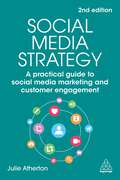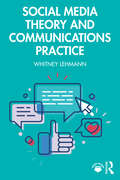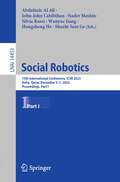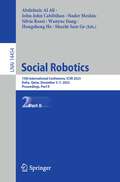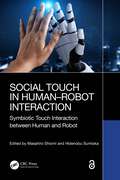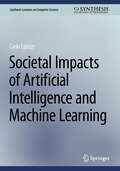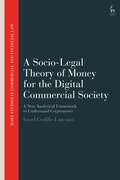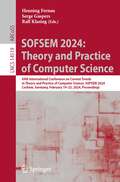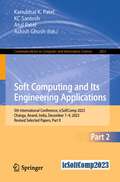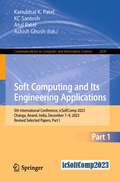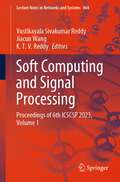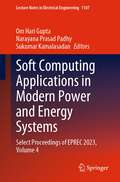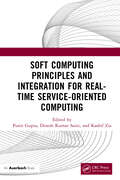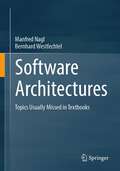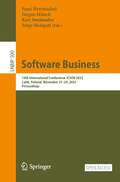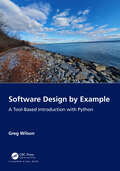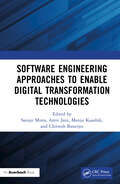- Table View
- List View
Social Media Strategy: A Practical Guide to Social Media Marketing and Customer Engagement
by Julie AthertonSocial media marketing is no longer optional. This book unpacks the winning formula for effective social media marketing complete with comprehensive updates and latest developments.Integrated marketing and PR strategies are a requirement for all businesses but with the explosion of social media and content marketing many organizations still struggle to know which channels to invest in and how to maximize their impact. Social Media Strategy gives clear guidance with a simple structured approach to executing campaigns that work. It provides a blueprint for planning, delivering and measuring social media's contribution to your business through:- Identifying and targeting audience segments - Maximizing social search - Enhanced reputation management - Managing a diversified influencer portfolio - Selecting the right channels for organic and paid social - Creating a process and structure to improve efficiencies- Using appropriate technology including AIWith explanations of best-practice tools and practical downloadable templates, this new edition includes new and updated interviews and case studies from industry leaders, influencers and brands including TUI, Greggs, Lego, Ryan Air, National Geographic and others. Social Media Strategy delivers a long-term solution for maximizing social media-led business development.
Social Media Strategy: A Practical Guide to Social Media Marketing and Customer Engagement
by Julie AthertonSocial media marketing is no longer optional. This book unpacks the winning formula for effective social media marketing complete with comprehensive updates and latest developments.Integrated marketing and PR strategies are a requirement for all businesses but with the explosion of social media and content marketing many organizations still struggle to know which channels to invest in and how to maximize their impact. Social Media Strategy gives clear guidance with a simple structured approach to executing campaigns that work. It provides a blueprint for planning, delivering and measuring social media's contribution to your business through:- Identifying and targeting audience segments - Maximizing social search - Enhanced reputation management - Managing a diversified influencer portfolio - Selecting the right channels for organic and paid social - Creating a process and structure to improve efficiencies- Using appropriate technology including AIWith explanations of best-practice tools and practical downloadable templates, this new edition includes new and updated interviews and case studies from industry leaders, influencers and brands including TUI, Greggs, Lego, Ryan Air, National Geographic and others. Social Media Strategy delivers a long-term solution for maximizing social media-led business development.
Social Media Theory and Communications Practice
by Whitney LehmannFusing the academic with the applied, this book provides a comprehensive introduction to social media for future communications professionals.While most social media texts approach the subject through either a theoretical, scholarly lens or a professional, practical lens, this text offers a much-needed linkage of theory to the practical tactics employed by social media communicators. Concise and conversational chapters break down the basics of both social media theory and practice and are complemented by sidebars written by scholars and industry professionals, chapter summaries and end-of-chapter exercises.This book is ideal for introductory social media courses in communication, public relations and mass communication departments, as well as courses in digital media and public relations.Online resources include social media writing templates, sample posts and content calendar templates. Please visit www.routledge.com/9781032185873.
Social Media Theory and Communications Practice
by Whitney LehmannFusing the academic with the applied, this book provides a comprehensive introduction to social media for future communications professionals.While most social media texts approach the subject through either a theoretical, scholarly lens or a professional, practical lens, this text offers a much-needed linkage of theory to the practical tactics employed by social media communicators. Concise and conversational chapters break down the basics of both social media theory and practice and are complemented by sidebars written by scholars and industry professionals, chapter summaries and end-of-chapter exercises.This book is ideal for introductory social media courses in communication, public relations and mass communication departments, as well as courses in digital media and public relations.Online resources include social media writing templates, sample posts and content calendar templates. Please visit www.routledge.com/9781032185873.
Social Robotics: 15th International Conference, ICSR 2023, Doha, Qatar, December 3–7, 2023, Proceedings, Part I (Lecture Notes in Computer Science #14453)
by Abdulaziz Al Ali John-John Cabibihan Nader Meskin Silvia Rossi Wanyue Jiang Hongsheng He Shuzhi Sam GeThe two-volume set LNAI 14453 and 14454 constitutes the refereed post-conference proceedings of the 15th International Conference on Social Robotics, ICSR 2023, held in Doha, Qatar, during December 4–7, 2023. The 68 revised full papers presented in these proceedings were carefully reviewed and selected from 83 submissions. They deal with topics around the interaction between humans and intelligent robots and on the integration of robots into the fabric of society. This year the special topic is "Human-Robot Collaboration: Sea; Air; Land; Space and Cyberspace”, focusing on all physical and cyber-physical domains where humans and robots collaborate.
Social Robotics: 15th International Conference, ICSR 2023, Doha, Qatar, December 3–7, 2023, Proceedings, Part II (Lecture Notes in Computer Science #14454)
by Abdulaziz Al Ali John-John Cabibihan Nader Meskin Silvia Rossi Wanyue Jiang Hongsheng He Shuzhi Sam GeThe two-volume set LNAI 14453 and 14454 constitutes the refereed post-conference proceedings of the 15th International Conference on Social Robotics, ICSR 2023, held in Doha, Qatar, during December 4–7, 2023. The 68 revised full papers presented in these proceedings were carefully reviewed and selected from 83 submissions. They deal with topics around the interaction between humans and intelligent robots and on the integration of robots into the fabric of society. This year the special topic is "Human-Robot Collaboration: Sea; Air; Land; Space and Cyberspace”, focusing on all physical and cyber-physical domains where humans and robots collaborate.
Social Touch in Human–Robot Interaction: Symbiotic touch interaction between human and robot
In this book for researchers and students, editors Shiomi and Sumioka bring together contributions from researchers working on the CREST project at ATR Deep Interaction Laboratories, a world leader in social robotics, to comprehensively describe robot touch systems from hardware to applications.Appropriate touch from robots to humans is essential for social robots, but achieving this requires various solutions at every stage of the touch process. Through this book, readers will gain an understanding of the needs, essential systems and communication cues, behaviour designs, and real‑world issues for social touch applications. This book compiles and updates technical and empirical research that was previously scattered throughout the literature into a single volume. Through individually authored chapters addressing various elements of ATR’s CREST project, this book tackles key areas where understanding is needed to realize acceptable touch interaction, including pre‑touch interaction, interaction design for touching and being touched, behaviour changes caused by touch interaction, and applications of social touch interaction. It introduces a touch sensor and robots developed by the authors, including several touch‑related behaviours and design policies. This approach will enable readers to easily apply this knowledge to their own social robotics programs. This book is invaluable for anyone who wishes to understand and develop social robots that physically interact with people.It is most beneficial for researchers and upper undergraduate and graduate students in the fields of human–robot/agent/computer interaction and social touch interaction and those in the broader fields of engineering, computer science, and cognitive science.
Social Touch in Human–Robot Interaction: Symbiotic touch interaction between human and robot
by Masahiro Shiomi Hidenobu SumiokaIn this book for researchers and students, editors Shiomi and Sumioka bring together contributions from researchers working on the CREST project at ATR Deep Interaction Laboratories, a world leader in social robotics, to comprehensively describe robot touch systems from hardware to applications.Appropriate touch from robots to humans is essential for social robots, but achieving this requires various solutions at every stage of the touch process. Through this book, readers will gain an understanding of the needs, essential systems and communication cues, behaviour designs, and real‑world issues for social touch applications. This book compiles and updates technical and empirical research that was previously scattered throughout the literature into a single volume. Through individually authored chapters addressing various elements of ATR’s CREST project, this book tackles key areas where understanding is needed to realize acceptable touch interaction, including pre‑touch interaction, interaction design for touching and being touched, behaviour changes caused by touch interaction, and applications of social touch interaction. It introduces a touch sensor and robots developed by the authors, including several touch‑related behaviours and design policies. This approach will enable readers to easily apply this knowledge to their own social robotics programs. This book is invaluable for anyone who wishes to understand and develop social robots that physically interact with people.It is most beneficial for researchers and upper undergraduate and graduate students in the fields of human–robot/agent/computer interaction and social touch interaction and those in the broader fields of engineering, computer science, and cognitive science.
Societal Impacts of Artificial Intelligence and Machine Learning (Synthesis Lectures on Computer Science)
by Carlo LipizziThis book goes beyond the current hype of expectations generated by the news on artificial intelligence and machine learning by analyzing realistic expectations for society, its limitations, and possible future scenarios for the use of this technology in our current society. Artificial Intelligence is one of the top topics today and is inflating expectations beyond what the technology can do in the foreseeable future. The future cannot be predicted, but the future of some elements of our society, such as technology, can be estimated. This book merges the modeling of human reasoning with the power of AI technology allowing readers to make more informed decisions about their personal or financial decisions or just being more educated on current technologies. This book presents a model that sketches potential future scenarios based on a discussion of the expectations today, the analysis of the current gap in the literature, and a view of possible futures in terms of technology and use cases. Specifically, this book merges literature on the technology aspects, the sociological impacts, and philosophical aspects.
A Socio-Legal Theory of Money for the Digital Commercial Society: A New Analytical Framework to Understand Cryptoassets (Hart Studies in Commercial and Financial Law)
by Israel Cedillo LazcanoThis book poses the question: do we need a new body of regulations and the constitution of new regulatory agents to face the evolution of money in the Fourth Industrial Revolution?After the Global Financial Crisis and the subsequent introduction of Distributed Ledger Technologies in monetary matters, multiple opinions claim that we are in the middle of a financial revolution that will eliminate the need for central banks and other financial institutions to form bonds of trust on our behalf. In contrast to these arguments, this book argues that we are not witnessing a revolutionary expression, but an evolutionary one that we can trace back to the very origin of money.Accordingly, the book provides academics, regulators and policy makers with a multidisciplinary analysis that includes elements such as the relevance of intellectual property rights, which are disregarded in the legal analysis of money. Furthermore, the book proposes the idea that traditional analyses on the exercise of the lex monetae ignore the role of inside monies and technological infrastructures developed and supported by the private sector, as exemplified in the evolution of the cryptoassets market and in cases such as Banco de Portugal v Waterlow & Sons.The book puts forward a proposal for the design and regulation of new payment systems and invites the reader to look beyond the dissemination of individual Distributed Ledger Technologies such as Bitcoin.
SOFSEM 2024: 49th International Conference on Current Trends in Theory and Practice of Computer Science, SOFSEM 2024, Cochem, Germany, February 19–23, 2024, Proceedings (Lecture Notes in Computer Science #14519)
by Henning Fernau Serge Gaspers Ralf KlasingThis book constitutes the proceedings of the 49th International Conference on Current Trends in Theory and Practice of Computer Science, SOFSEM 2024, held in Cochem, Germany, in February 2024. The 33 full papers presented in this book were carefully reviewed and selected from 81 submissions. The book also contains one invited talk in full paper length. They focus on original research and challenges in foundations of computer science including algorithms, AI-based methods, computational complexity, and formal models.
Soft Computing and Its Engineering Applications: 5th International Conference, icSoftComp 2023, Changa, Anand, India, December 7–9, 2023, Revised Selected Papers, Part II (Communications in Computer and Information Science #2031)
by Kanubhai K. Patel Kc Santosh Atul Patel Ashish GhoshThe two-volume proceedings constitutes the refereed proceedings of the 5th International Conference on Soft Computing and its Engineering Applications, icSoftComp 2023, held in Changa, Anand, India, in December 2023. The 42 full papers and 2 short papers included in this book were carefully reviewed and selected from 351 submissions. They are organized in topical sections as follows: Volume number 2020: Theory and Methods; Systems and ApplicationsVolume number 2031: Systems and Applications; Hybrid Techniques.
Soft Computing and Its Engineering Applications: 5th International Conference, icSoftComp 2023, Changa, Anand, India, December 7–9, 2023, Revised Selected Papers, Part I (Communications in Computer and Information Science #2030)
by Kanubhai K. Patel Kc Santosh Atul Patel Ashish GhoshThe two-volume proceedings constitutes the refereed proceedings of the 5th International Conference on Soft Computing and its Engineering Applications, icSoftComp 2023, held in Changa, Anand, India, in December 2023. The 42 full papers and 2 short papers included in this book were carefully reviewed and selected from 351 submissions. They are organized in topical sections as follows: Volume number 2020: Theory and Methods; Systems and ApplicationsVolume number 2031: Systems and Applications; Hybrid Techniques.
Soft Computing and Signal Processing: Proceedings of 6th ICSCSP 2023, Volume 1 (Lecture Notes in Networks and Systems #864)
by Vustikayala Sivakumar Reddy Jiacun Wang K. T. V. ReddyThis book presents selected research papers on current developments in the fields of soft computing and signal processing from the Sixth International Conference on Soft Computing and Signal Processing (ICSCSP 2023). The book covers topics such as soft sets, rough sets, fuzzy logic, neural networks, genetic algorithms and machine learning and discusses various aspects of these topics, e.g., technological considerations, product implementation and application issues.
Soft Computing Applications in Modern Power and Energy Systems: Select Proceedings of EPREC 2023, Volume 4 (Lecture Notes in Electrical Engineering #1107)
by Om Hari Gupta Narayana Prasad Padhy Sukumar KamalasadanThis book includes select proceedings of EPREC 2023. It provides rigorous discussions, case studies, and recent developments in the areas of soft computing and its applications in power systems enabled with power electronics-based equipment, energy systems, and the energy community. The other topics to be covered are optimal planning, analysis, operation, and control related to modern power and energy systems, and applications of various soft computing methodologies. The readers find this book useful for enhancing their knowledge and skills in the domain areas.
Soft Computing Principles and Integration for Real-Time Service-Oriented Computing
In recent years, soft computing techniques have emerged as a successful tool to understand and analyze the collective behavior of service- oriented computing software. Algorithms and mechanisms of self- organization of complex natural systems have been used to solve problems, particularly in complex systems, which are adaptive, ever- evolving, and distributed in nature across the globe. What fits more perfectly into this scenario other than the rapidly developing era of Fog, IoT, and Edge computing environment? Service- oriented computing can be enhanced with soft computing techniques embedded inside the Cloud, Fog, and IoT systems.Soft Computing Principles and Integration for Real-Time Service-Oriented Computing explores soft computing techniques that have wide application in interdisciplinary areas. These soft computing techniques provide an optimal solution to the optimization problem using single or multiple objectives.The book focuses on basic design principles and analysis of soft computing techniques. It discusses how soft computing techniques can be used to improve quality-of-service in serviceoriented architectures. The book also covers applications and integration of soft computing techniques with a service- oriented computing paradigm. Highlights of the book include: A general introduction to soft computing An extensive literature study of soft computing techniques and emerging trends Soft computing techniques based on the principles of artificial intelligence, fuzzy logic, and neural networks The implementation of SOC with a focus on service composition and orchestration, quality of service (QoS) considerations, security and privacy concerns, governance challenges, and the integration of legacy systems The applications of soft computing in adaptive service composition, intelligent service recommendation, fault detection and diagnosis, SLA management, and security Such principles underlying SOC as loose coupling, reusability, interoperability, and abstraction An IoT based framework for real time data collection and analysis using soft computing
Soft Computing Principles and Integration for Real-Time Service-Oriented Computing
by Punit Gupta Dinesh Kumar Saini Kashif ZiaIn recent years, soft computing techniques have emerged as a successful tool to understand and analyze the collective behavior of service- oriented computing software. Algorithms and mechanisms of self- organization of complex natural systems have been used to solve problems, particularly in complex systems, which are adaptive, ever- evolving, and distributed in nature across the globe. What fits more perfectly into this scenario other than the rapidly developing era of Fog, IoT, and Edge computing environment? Service- oriented computing can be enhanced with soft computing techniques embedded inside the Cloud, Fog, and IoT systems.Soft Computing Principles and Integration for Real-Time Service-Oriented Computing explores soft computing techniques that have wide application in interdisciplinary areas. These soft computing techniques provide an optimal solution to the optimization problem using single or multiple objectives.The book focuses on basic design principles and analysis of soft computing techniques. It discusses how soft computing techniques can be used to improve quality-of-service in serviceoriented architectures. The book also covers applications and integration of soft computing techniques with a service- oriented computing paradigm. Highlights of the book include: A general introduction to soft computing An extensive literature study of soft computing techniques and emerging trends Soft computing techniques based on the principles of artificial intelligence, fuzzy logic, and neural networks The implementation of SOC with a focus on service composition and orchestration, quality of service (QoS) considerations, security and privacy concerns, governance challenges, and the integration of legacy systems The applications of soft computing in adaptive service composition, intelligent service recommendation, fault detection and diagnosis, SLA management, and security Such principles underlying SOC as loose coupling, reusability, interoperability, and abstraction An IoT based framework for real time data collection and analysis using soft computing
Software Architecture Patterns for Serverless Systems: Architecting for innovation with event-driven microservices and micro frontends
by John GilbertDelve into the second edition to master serverless proficiency and explore new chapters on security techniques, multi-regional deployment, and optimizing observability.Key FeaturesGain insights from a seasoned CTO on best practices for designing enterprise-grade software systemsDeepen your understanding of system reliability, maintainability, observability, and scalability with real-world examplesElevate your skills with software design patterns and architectural concepts, including securing in-depth and running in multiple regionsBook DescriptionOrganizations undergoing digital transformation rely on IT professionals to design systems to keep up with the rate of change while maintaining stability. With this edition, enriched with more real-world examples, you’ll be perfectly equipped to architect the future for unparalleled innovation. This book guides through the architectural patterns that power enterprise-grade software systems while exploring key architectural elements (such as events-driven microservices, and micro frontends) and learning how to implement anti-fragile systems. First, you'll divide up a system and define boundaries so that your teams can work autonomously and accelerate innovation. You'll cover the low-level event and data patterns that support the entire architecture while getting up and running with the different autonomous service design patterns. This edition is tailored with several new topics on security, observability, and multi-regional deployment. It focuses on best practices for security, reliability, testability, observability, and performance. You'll be exploring the methodologies of continuous experimentation, deployment, and delivery before delving into some final thoughts on how to start making progress. By the end of this book, you'll be able to architect your own event-driven, serverless systems that are ready to adapt and change.What you will learnExplore architectural patterns to create anti-fragile systemsFocus on DevSecOps practices that empower self-sufficient, full-stack teamsApply microservices principles to the frontendDiscover how SOLID principles apply to software and database architectureGain practical skills in deploying, securing, and optimizing serverless architecturesDeploy a multi-regional system and explore the strangler pattern for migrating legacy systemsMaster techniques for collecting and utilizing metrics, including RUM, Synthetics, and Anomaly detectionWho this book is forThis book is for software architects who want to learn more about different software design patterns and best practices. This isn't a beginner's manual – you'll need an intermediate level of programming proficiency and software design experience to get started.You'll get the most out of this software design book if you already know the basics of the cloud, but it isn't a prerequisite.
Software Architecture with C# 12 and .NET 8: Build enterprise applications using microservices, DevOps, EF Core, and design patterns for Azure
by Gabriel Baptista Francesco AbbruzzeseA book for the aspiring .NET software architect – design scalable and high-performance enterprise solutions using the latest features of C# 12 and .NET 8 Purchase of the print or Kindle book includes a free PDF eBookKey FeaturesGet introduced to software architecture fundamentals and begin applying them in .NETExplore the main technologies used by software architects and choose the best ones for your needsMaster new developments in .NET with the help of a practical case study that looks at software architecture for a travel agencyBook DescriptionSoftware Architecture with C# 12 and .NET 8 puts high-level design theory to work in a .NET context, teaching you the key skills, technologies, and best practices required to become an effective .NET software architect. This fourth edition puts emphasis on a case study that will bring your skills to life. You’ll learn how to choose between different architectures and technologies at each level of the stack. You’ll take an even closer look at Blazor and explore OpenTelemetry for observability, as well as a more practical dive into preparing .NET microservices for Kubernetes integration. Divided into three parts, this book starts with the fundamentals of software architecture, covering C# best practices, software domains, design patterns, DevOps principles for CI/CD, and more. The second part focuses on the technologies, from choosing data storage in the cloud to implementing frontend microservices and working with Serverless. You’ll learn about the main communication technologies used in microservices, such as REST API, gRPC, Azure Service Bus, and RabbitMQ. The final part takes you through a real-world case study where you’ll create software architecture for a travel agency. By the end of this book, you will be able to transform user requirements into technical needs and deliver highly scalable enterprise software architectures.What you will learnProgram and maintain Azure DevOps and explore GitHub ProjectsManage software requirements to design functional and non-functional needsApply architectural approaches such as layered architecture and domain-driven designMake effective choices between cloud-based and data storage solutionsImplement resilient frontend microservices, worker microservices, and distributed transactionsUnderstand when to use test-driven development (TDD) and alternative approachesChoose the best option for cloud development, from IaaS to ServerlessWho this book is forThis book is for engineers and senior software developers aspiring to become architects or looking to build enterprise applications with the .NET stack. Basic familiarity with C# and .NET is required to get the most out of this software architecture book.
Software Architectures: Topics Usually Missed in Textbooks
by Manfred Nagl Bernhard WestfechtelThis textbook concentrates on processes, activities and results related to software architectures. It describes the separation of architecture artefacts corresponding to their nature, their logical or their modeling level on one hand and at the same time emphasizes their integration based on their mutual relations. Design or development processes demand for integration, as different artifacts must be elaborated, which are mutually dependent and need to be in a consistent form. The book is structured in four parts. The introductory Part I deals with the relevance of architectures, the central role of the design subprocess both in development or maintenance, and the importance of the decisions and artefacts in the overall result. Another topic is the spectrum of views an architecture language has to offer, and that there are different architectures to be regarded, from abstract and static to detailed, technical, and specific. Part II then discusses “important topics” onthe architecture level. It deals with adaptability especially for embedded systems, with integrating styles/ pattern notations, with different reuse forms and how to find them, with the role of architectures for integrating different existing systems, and with reverse and reengineering of legacy systems. Next, Part III covers architecture modeling and its relation to surrounding activities, as well as architectures to surrounding other results. The single chapters are on transformation between requirements and architectures, architectures and programming, architectures and project management and organization, as well as architectures and their relations to quality assurance or documentation. Eventually, Part IV summarizes the main messages and presents open problems, both for every single chapter and across chapters. Every chapter focuses on a specific problem it addresses, a question it answers, the attention it demands, a message it conveys, and further open questions it raises. The chapters are mostly independent, which implies a certain redundancy, yet it allows lecturers (and their students) to either use the book as the basis of teaching software architecture or design, or to just pick those aspects that need special attention in a more advanced course.
Software Business: 14th International Conference, ICSOB 2023, Lahti, Finland, November 27–29, 2023, Proceedings (Lecture Notes in Business Information Processing #500)
by Sami Hyrynsalmi Jürgen Münch Kari Smolander Jorge MelegatiThis open access book constitutes the refereed proceedings of the 23rd International Conference on Software Business, ICSOB 2023, which was held in Lahti, Finland, during November 27–29, 2023. The special theme of ICSOB 2023 was Digital Agility: Mastering Change in Software Business and Digital Services.The 27 full papers and 8 short papers presented in this book were carefully reviewed and selected from 79 submissions. They were organized in topical sections as follows: Requirements; software procurement; platforms, ecosystems and data; artificial intelligence; software startups; software product management; software and business co-development; and emerging digital world.
Software Design by Example: A Tool-Based Introduction with Python
by Greg WilsonThe best way to learn design in any field is to study examples, and some of the best examples of software design come from the tools programmers use in their own work. Software Design by Example: A Tool-Based Introduction with Python therefore builds small versions of the things programmers use in order to demystify them and give some insights into how experienced programmers think. From a file backup system and a testing framework to a regular expression matcher, a browser layout engine, and a very small compiler, we explore common design patterns, show how making code easier to test also makes it easier to reuse, and help readers understand how debuggers, profilers, package managers, and version control systems work so that they can use them more effectively.This material can be used for self-paced study, in an undergraduate course on software design, or as the core of an intensive weeklong workshop for working programmers. Each chapter has a set of exercises ranging in size and difficulty from half a dozen lines to a full day’s work. Readers should be familiar with the basics of modern Python, but the more advanced features of the language are explained and illustrated as they are introduced.All the written material in this project can be freely reused under the terms of the Creative Commons - Attribution license, while all of the software is made available under the terms of the Hippocratic License. All proceeds from sale of this book will go to support the Red Door Family Shelter in Toronto.Features:• Teaches software design by showing programmers how to build the tools they useevery day• Each chapter includes exercises to help readers check and deepen their understanding• All the example code can be downloaded, re-used, and modified under an open license
Software Design by Example: A Tool-Based Introduction with Python
by Greg WilsonThe best way to learn design in any field is to study examples, and some of the best examples of software design come from the tools programmers use in their own work. Software Design by Example: A Tool-Based Introduction with Python therefore builds small versions of the things programmers use in order to demystify them and give some insights into how experienced programmers think. From a file backup system and a testing framework to a regular expression matcher, a browser layout engine, and a very small compiler, we explore common design patterns, show how making code easier to test also makes it easier to reuse, and help readers understand how debuggers, profilers, package managers, and version control systems work so that they can use them more effectively.This material can be used for self-paced study, in an undergraduate course on software design, or as the core of an intensive weeklong workshop for working programmers. Each chapter has a set of exercises ranging in size and difficulty from half a dozen lines to a full day’s work. Readers should be familiar with the basics of modern Python, but the more advanced features of the language are explained and illustrated as they are introduced.All the written material in this project can be freely reused under the terms of the Creative Commons - Attribution license, while all of the software is made available under the terms of the Hippocratic License. All proceeds from sale of this book will go to support the Red Door Family Shelter in Toronto.Features:• Teaches software design by showing programmers how to build the tools they useevery day• Each chapter includes exercises to help readers check and deepen their understanding• All the example code can be downloaded, re-used, and modified under an open license
The Software Developer's Guide to Linux: A practical, no-nonsense guide to using the Linux command line and utilities as a software developer
by David Cohen Christian SturmA must-read for software developers lacking command-line skills, focusing on Linux. It provides transferable command-line proficiency for use in Mac OS, Unix, and Windows with WSLKey FeaturesA practical, no-nonsense guide specifically written for developers (not sysadmins) who need to quickly learn command-line skillsExpand your practical skills and look like a wizard on the command lineBuild practical skills to work effectively with the most common CLI tools on Unix-like systemsBook DescriptionDevelopers are always looking to raise their game to the next level, yet most are completely lost when it comes to the Linux command line. This book is the bridge that will take you to the next level in your software development career. Most of the skills in the book can be immediately put to work to make you a more efficient developer. It’s written specifically for software engineers, not Linux system administrators, so each chapter will equip you with just enough theory to understand what you’re doing before diving into practical commands that you can use in your day-to-day work as a software developer. As you work through the book, you’ll quickly absorb the basics of how Linux works while you get comfortable moving around the command line. Once you’ve got the core skills, you’ll see how to apply them in different contexts that you’ll come across as a software developer: building and working with Docker images, automating boring build tasks with shell scripts, and troubleshooting issues in production environments. By the end of the book, you’ll be able to use Linux and the command line comfortably and apply your newfound skills in your day-to-day work to save time, troubleshoot issues, and be the command-line wizard that your team turns to.What you will learnLearn useful command-line tricks and tools that make software development, testing, and troubleshooting easyUnderstand how Linux and command line environments actually workCreate powerful, customized tools and save thousands of lines of code with developer-centric Linux utilitiesGain hands-on experience with Docker, SSH, and Shell scripting tasks that make you a more effective developerGet comfortable searching logs and troubleshooting problems on Linux serversHandle common command-line situations that stump other developersWho this book is forThis book is for software developers who want to build practical Command-Line (CLI) and Linux skills and who want to quickly fill the gap to advance their skills and their career. Basic knowledge of editing text, working with files and folders, having some idea of what “operating systems” are, installing software, and using a development environment is assumed.
Software Engineering Approaches to Enable Digital Transformation Technologies
Software Engineering Approaches to Enable Digital Transformation Technologies features contributions reflecting ideas and research in enabling digital transformation technologies through software engineering. To date, multiple, different approaches have been adopted to develop software solutions for a variety of different problems. Of all the available approaches, the main approaches are level-oriented, data flow-oriented, data structure-oriented, and object-oriented design approaches. The other focus of the book is digital transformation, which can be defined as the adoption of digital technology to improve efficiency, value, and innovation Digitalization is more than just putting additional technological systems and services in place. Rather than improving conventional methods, a true digital transformation initiative includes radically rethinking company structures and procedures. There are four types of digital transformation: business process, business model, domain, and cultural and organizational. Companies are being challenged to develop new business models that consider and harness digitalization. From the standpoint of software engineering, digital transformation alters how software is built. Current trends include the development of mobile applications, cloud applications, and Internet of Things (IoT) applications. Emerging trends are the development of digital twins, robotics, artificial intelligence, machine learning, augmented reality, and additive manufacturing. This book examines the challenges that arise due to digitization in society and presents plausible solutions that could be applied to counter these challenges and convert them into opportunities. These solutions may further be improvised and worked out for the software companies from the technological perspective, organizational perspective, and management perspective.
